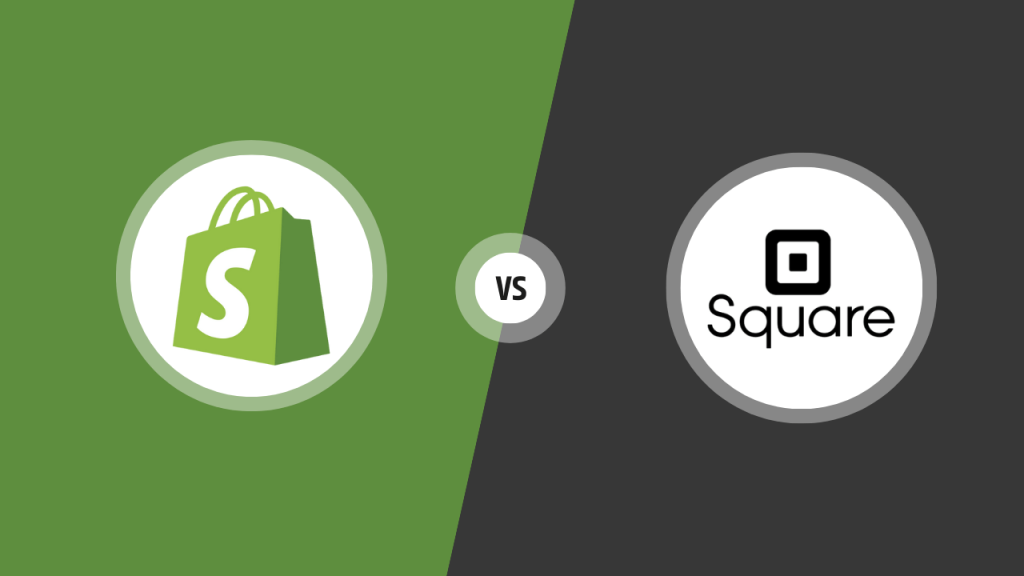In this article, we are set to explore the intricate details of the popular ecommerce platforms, Shopify and Square, comparing them across various parameters such as ease of use, features, pricing, customizability, and payment processing. We will also look at the pros and cons to offer a comprehensive perspective. A verdict will be provided based on their unique strengths and suitability for different business types.
Understanding the basics
Shopify
Shopify provides a comprehensive suite of tools to create and manage an online store. This includes the ability to customize the look and feel of the store, add and manage products, handle inventory, track sales, manage payments, and much more. It also includes tools for search engine optimization (SEO) and marketing to help businesses reach their target audience and grow their customer base.
In addition to its core ecommerce platform, Shopify also offers an in-person point of sale (POS) system, allowing businesses to sell in physical locations like retail stores, pop-up shops, and markets while managing all their sales and inventory in one place.
As of 2023, Shopify is used in over 175 countries globally and is used by 4.12 million online stores.
Square
Square is a financial services and mobile payment company based in the United States. Over the years, Square has expanded its range of services and now offers a complete suite of business and payment solutions. These include a Point of Sale (POS) system, an online store builder, appointment booking, payroll services, business loans through Square Capital, and more.
Square’s POS system is a powerful tool for businesses, allowing them to manage sales, inventory, and customer information all in one place. The online store builder enables businesses to sell their products online and integrates seamlessly with the POS system, allowing for unified inventory management across both physical and online sales channels.
Square’s broad range of business tools and services are designed to work together seamlessly, providing an integrated business management solution for both online and brick-and-mortar businesses.
Shopify vs Square: Detailed comparison

Shopify and Square: Ease of use
Shopify
Shopify is widely recognized for its ease of use, making it a popular choice among businesses of all sizes. The platform is designed to be user-friendly and intuitive, which means that even those without technical expertise can quickly learn to navigate and use its features.
When a user first signs up for Shopify, they are guided through the process of setting up their online store. This includes choosing a theme, customizing the look and feel of the store, adding products, and setting up payment and shipping options. Each step is clearly outlined, and help is readily available if needed.
The Shopify dashboard, which serves as the main hub for managing the online store, is clean and well-organized. Users can easily access all of the platform’s features from this dashboard, including adding and managing products, monitoring and fulfilling orders, analyzing sales data, and more.
In addition to its core features, Shopify offers a range of apps that can be added to the online store for extra functionality. These apps cover various needs, from SEO and marketing tools to customer reviews and loyalty programs. This makes it easy for businesses to customize their store to meet their specific needs.
Learn how to create your own Shopify store with our comprehensive guide.
Square
Square also is known for its straightforward, user-friendly interface, which makes it accessible to businesses of all sizes and individuals without technical expertise. The platform is designed with simplicity and efficiency in mind, ensuring that even new users can set up and start using its features in a short period of time.
Setting up with Square is quite straightforward. You can sign up for an account, download the app, and start accepting payments immediately. If you’re using the Square reader to accept physical card payments, connecting it to your device and setting it up is also a simple process.
Square’s Point of Sale (POS) system features an intuitive interface that makes it easy to add and manage products, process transactions, and track sales. The POS system is also customizable, allowing businesses to set up their product categories and items in a way that makes the most sense for their operations.
In terms of online selling, Square offers an Online Store builder that lets businesses set up an ecommerce site that syncs seamlessly with the physical POS system. Like the POS system, the Online Store builder is designed to be easy to use, allowing businesses to create a professional-looking online store without knowing how to code.
Shopify and Square: Features
Shopify features
Shopify provides an extensive suite of features tailored to cater to the varying needs of online businesses.
Online store builder
Shopify provides a range of professionally designed themes (both free and paid) that you can use to design your online store. You have the flexibility to customize nearly every aspect of your store’s look and feel.
Shopping cart
Shopify provides a secure shopping cart that is automatically set up when you create your store. It supports a wide range of payment gateways and allows you to set custom shipping rates.
Product management
You can add unlimited products and product variants (like colors and sizes) to your Shopify store. There are also tools to manage your inventory and track stock levels.
Marketing and SEO tools
Shopify comes with several built-in SEO features to help your store rank higher in search engine results. Additionally, it offers a range of marketing tools like discount codes, gift cards, social media integration, and the ability to run email marketing campaigns.
Reports and analytics
Shopify provides detailed reports on your store’s performance, allowing you to understand your sales, customer behavior, and other valuable metrics. You can track and analyze this data to make informed decisions for your business.
App integrations
Shopify’s App Store has thousands of apps that can extend the functionality of your store. These cover everything from email marketing, and customer reviews to accounting and shipping.
Point of Sale (POS)
Shopify’s POS system allows you to sell products online and in physical locations like retail stores, pop-up shops, and markets. The POS system syncs with your online store, so your inventory and sales data are always up to date, no matter where the sales are made.
Square features
Square, in contrast, focuses on serving the needs of both brick-and-mortar and online stores.
Payment processing
Square’s core feature is its payment processing capabilities. It allows businesses to accept a variety of payment methods, including credit and debit cards, digital wallets, and more.
Point of Sale (POS)
Square’s POS system is a robust tool for managing sales, inventory, and customer information. It’s customizable and can cater to different types of businesses, from retail to restaurants and services.
Inventory management
Square provides tools for tracking and managing your inventory across multiple locations. You can receive alerts when stock is low, and the system automatically updates inventory levels when sales are made.
Invoices and digital receipts
You can create and send professional digital invoices right from your Square Dashboard. Also, Square provides digital receipts that can be texted or emailed to customers.
Reports and analytics
Square provides robust reporting and analytics features, giving businesses valuable insights into sales trends, customer behavior, and other important metrics.
Customer directory
Square allows you to build a directory of your customers, tracking their purchases and providing insights into their behavior. This can be valuable for building relationships and implementing loyalty programs.
Shopify and Square: Pricing
Shopify pricing
Shopify provides a tiered pricing model to cater to businesses from small to large scale. It offers three main plans:
- Basic Shopify ($39/month): for individuals and small businesses;
- Shopify ($105/month): for small businesses;
- Advanced Shopify ($399/month): for medium to large businesses.
As you move up the tiers, the range of features and capabilities increases, with the Advanced Shopify offering the most comprehensive set of tools.
Square pricing
Square’s pricing structure includes three main plans plus a fee per transaction (depending on transaction type):
- Square Free plan: $0/mo and 2.9% + $0.30 per transaction;
- Square Plus plan: $29/mo (billed annually) and 2.9% + $0.30 per transaction;
- Square Premium plan: $79/mo (billed annually) and 2.6% + $0.30 per transaction.
Shopify and Square: Customizability
Shopify customizability
Shopify excels in offering a high degree of customizability. It offers a selection of over 70 themes, both free and paid, which are all mobile responsive. The platform also allows for direct editing of HTML and CSS, offering businesses the flexibility to tailor their storefronts down to the finest details. Furthermore, Shopify’s App Store offers over 4,000 apps for added functionality, from marketing to inventory management, allowing businesses to extend the platform’s capabilities.
Square customizability
Square’s customizability, in comparison, is somewhat limited. While it does offer a variety of website themes, the ability to customize these themes is not as extensive as Shopify. The Square Online Store is easy to set up and use, making it a great option for businesses looking for simplicity over high customizability.
Shopify and Square: Payment processing
Shopify payment processing
Shopify provides several options for payment processing, giving merchants the flexibility to choose the one that best suits their business needs. Here are the key options available:
Shopify Payments
This is Shopify’s own integrated payment gateway, which is powered by Stripe. When you use Shopify Payments, you can manage your entire business and financials in one place. It accepts all major credit cards and several other payment methods. Shopify Payments has its own fee structure, but the advantage is that there are no additional transaction fees when it is used.
Third-party payment gateways
Shopify also integrates with over 100 third-party payment gateways like PayPal, Amazon Pay, and Apple Pay. This gives you the flexibility to choose the payment gateway that best suits your needs. However, keep in mind that transaction fees may apply when using these gateways, depending on your Shopify plan.
Manual payment methods
Shopify supports manual payment options like Cash on Delivery (COD), Bank Deposit, and Money Orders. This can be useful for businesses that also have offline sales channels.
Shopify POS
With Shopify’s POS system, you can accept payments in person using a card reader. This is beneficial for businesses that operate both online and offline stores, as it allows them to manage all their sales and inventory in one place.
Square payment processing
Square’s main value proposition is its simplified payment processing system that allows businesses to accept a variety of payment methods both online and in person. Here are the key aspects of Square’s payment processing:
Square Reader
Square is well-known for its iconic card reader, which plugs into a smartphone or tablet, turning it into a mobile Point of Sale (POS). This allows businesses to accept credit and debit card payments wherever they are. Square also offers a contactless chip reader that can accept tap-and-go cards, chip cards, and mobile wallets like Apple Pay and Google Pay.
Square Stand and Square Terminal
For brick-and-mortar businesses, Square provides hardware options like the Square Stand for iPads and the all-in-one Square Terminal that can accept card payments, print receipts, and more.
Invoicing and virtual terminal
Square allows you to create and send invoices right from your dashboard, and customers can pay them online. Additionally, the virtual terminal feature lets you manually enter credit card payments on your computer.
Square Payments
Like Shopify Payments, Square has its own integrated payment system, Square Online Payments. It supports all major credit cards and digital wallets, and funds from sales are usually available in your linked bank account as soon as the next business day. As well as Square integrates with PayPal and lots of the API and third-party payment gateaways.
Shopify and Square: Pros and cons
Shopify pros
User-friendly
Shopify is well-known for its intuitive user interface and ease of use. Even those without technical skills can easily create a professional-looking online store.
Comprehensive ecommerce features
Shopify provides a wide range of features necessary for running an online store, including product management, inventory tracking, SEO tools, marketing capabilities, and more.
App integrations
Shopify’s App Store has thousands of apps that can extend the functionality of your store, covering a wide range of needs, from email marketing to accounting, thereby allowing you to customize your store to meet your specific requirements.
Scalability
Shopify can comfortably accommodate businesses as they grow, making it an excellent choice for both small businesses and larger enterprises.
Multichannel selling
Shopify allows you to sell on multiple channels like Facebook, Instagram, Amazon, eBay, and more, all managed from the Shopify dashboard.
Shopify cons
Additional costs
Shopify’s pricing can become expensive, especially once you start adding premium themes, paid apps, and advanced features. These additional costs can add up, particularly for smaller businesses.
Transaction fees
If you choose to use a third-party payment gateway instead of Shopify Payments, you’ll be charged additional transaction fees. These fees vary depending on your Shopify plan.
Limited customization with basic plans
The customization options for the appearance of your store can be limited unless you are comfortable with coding or are willing to hire a developer.
Migration challenges
If you decide to move to a different platform in the future, migrating your store away from Shopify can be a complicated process.
Square pros
Unified ecosystem
One of Square’s greatest strengths is its cohesive ecosystem, which syncs online and in-person sales. This is great for businesses that operate both physical stores and online sales channels.
Flexible payment options
Square supports a wide range of payment methods, including credit/debit cards, digital wallets, and more. Its iconic card reader is portable, making it easy to accept payments on the go.
Transparent pricing
Square’s pricing is simple and transparent. It charges a flat rate for each transaction, and there are no hidden fees.
Strong analytics and reporting
Square’s comprehensive analytics and reporting tools offer valuable insights into sales trends, customer behavior, and other key business metrics.
No monthly fees
Unlike many other POS systems, Square does not charge a monthly fee. You only pay when you make a sale.
Square cons
Limited customization
If we’re talking about Square Online as an ecommerce store, Square offers limited customization options compared to other ecommerce platforms. While you can certainly run a functional online store, it may not have the visual appeal and uniqueness of stores built on more customizable platforms.
Costs for advanced features
While Square’s basic POS app is free, some advanced features come with additional costs. This can increase your expenses as your business grows and requires more advanced tools.
Less suitable for large businesses
While Square is excellent for small businesses, it may not be the best choice for large businesses or enterprises due to its pricing structure and feature set.
Lacks advanced ecommerce features
Compared to dedicated ecommerce platforms like Shopify, Square’s ecommerce features are somewhat basic. This could limit some online businesses.
Is it possible to use both Shopify and Square?
Yes, it is indeed possible to use both Shopify and Square together. They can be integrated to leverage the strengths of each platform, creating a more powerful and versatile business solution.
Shopify can be used to build and manage your online store, benefiting from its robust ecommerce features, extensive customization options, and app integrations. On the other hand, Square can be used to handle in-person sales with its various POS hardware options and easy-to-use interface.
In 2020, Shopify and Square announced an integration that allows Shopify users to use Square for in-person payments. This means that you can use Square to process all your in-person transactions while Shopify syncs your online and offline inventory, manages your products, and handles all other eCommerce operations.
This kind of setup can be particularly beneficial for businesses with both a strong online presence and a physical storefront or those who participate in events like pop-up shops or markets.
However, keep in mind that running both systems might increase your costs, as you will have to deal with the costs associated with both platforms, such as transaction fees and hardware costs. Furthermore, managing multiple systems might also require more time and resources.
Shopify and Square: Conclusion
The choice between Shopify and Square ultimately boils down to your business needs. If you are an ecommerce business looking for extensive customization and advanced online selling tools, Shopify is likely the better choice. On the other hand, if you run a brick-and-mortar store and want to establish an online presence with integrated payment processing, Square might be the more suitable option.

.png)




